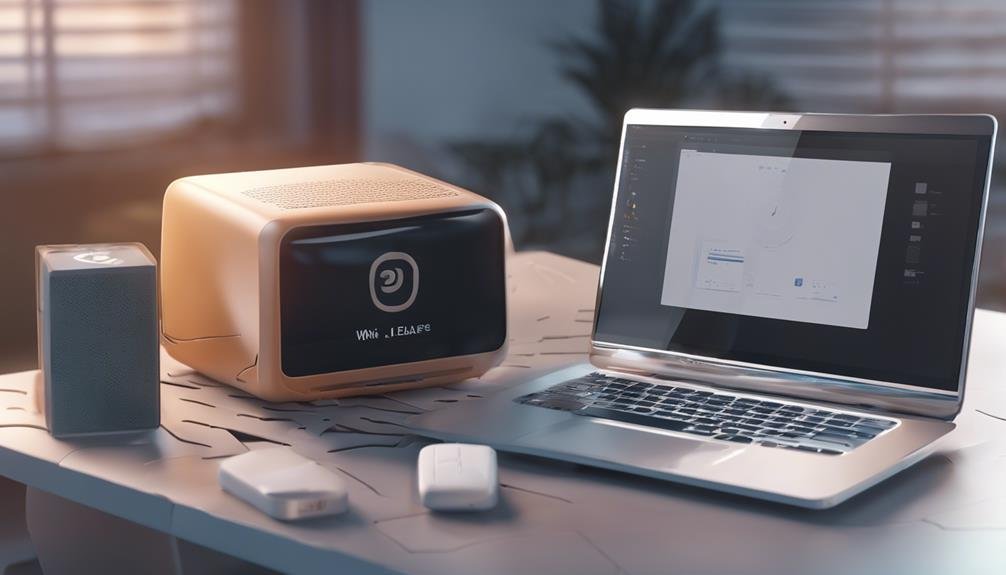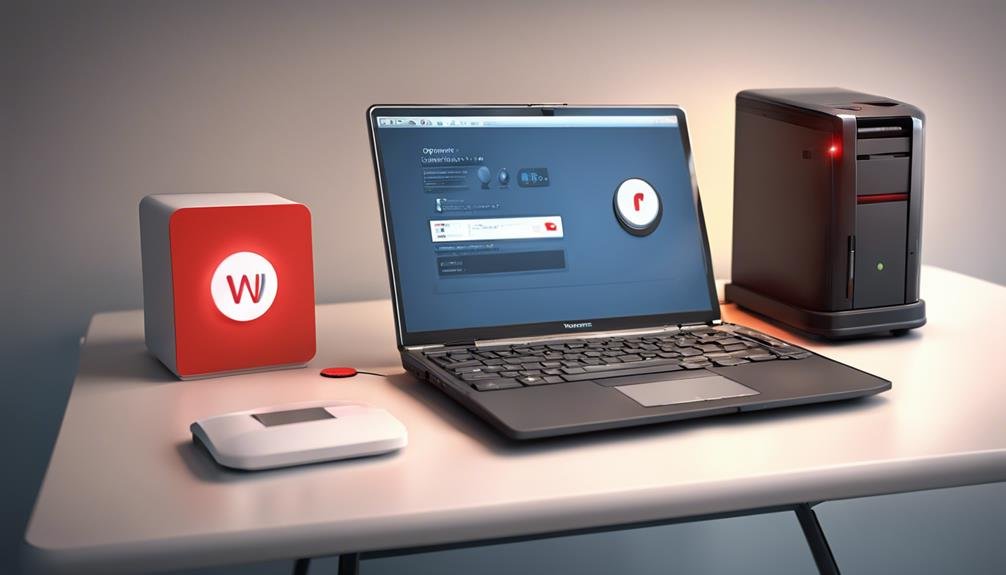You have two primary methods to connect to a printer wirelessly: Wi-Fi printing technology and Bluetooth printing technology. Wi-Fi printing relies on IEEE 802.11 standards to establish wireless connectivity within a network range, allowing you to print from multiple devices and access cloud-based services like Google Cloud Print. Bluetooth printing, on the other hand, facilitates direct communication between devices for instant printing without a traditional network connection, ideal for short-distance printing within a 10-meter range. As you investigate these wireless printing methods, you'll uncover the unique benefits and advantages each has to offer.
Understanding Wi-Fi Printing Technology
When you delve into the world of wireless printing, you'll find that Wi-Fi printers rely on IEEE 802.11 standards to establish wireless connectivity within a defined network range. This allows for seamless communication between your devices and the printer, enabling efficient printing without the hassle of cables.
Wi-Fi printers can also connect to cloud-based services like Google Cloud Print or AirPrint, which enables printing from different devices, including smartphones and tablets. This means you can print documents or photos from anywhere, at any time, as long as you have an internet connection.
With Wi-Fi technology, you can access advanced printer features remotely via a web browser or app, making it easy to monitor and control your printer's settings. By leveraging IEEE 802.11 standards and cloud-based services, Wi-Fi printers provide unparalleled convenience and flexibility, making them an attractive option for individuals and businesses alike.
Benefits of Wi-Fi Printing
By embracing Wi-Fi printing, you'll experience the freedom to print from multiple devices, share a printer with others, and enjoy improved convenience through cloud-based services. This technology allows you to print from anywhere within your network range, giving you the flexibility to work from different locations without being tethered to a specific printer.
One of the significant benefits of Wi-Fi printing is the ability to share a printer with other users on the same Wi-Fi network, making it an excellent option for households or offices with multiple devices. Additionally, you can access advanced printer features remotely via a web browser or app, adding to the convenience factor.
With Wi-Fi printing, you can also take advantage of cloud-based services like Google Cloud Print or AirPrint, which enable you to print from your devices even when you're not on the same network. In sum, Wi-Fi printing offers a range of benefits that can simplify your printing experience and boost your productivity.
How Bluetooth Printing Works

You can now explore another wireless printing option, Bluetooth printing, which facilitates direct communication between devices for instant printing without relying on a traditional network connection.
This wireless technology enables devices to pair with each other, allowing you to print directly from your device without the need for a traditional network. Bluetooth printing offers a simple and fast setup process, making it convenient for you to start printing right away.
Since it's ideal for short-distance printing, typically within a range of around 10 meters, you can easily move your device around to find the perfect printing spot. Through Bluetooth connectivity, you can print from your device without requiring network access, making it a great option for those who need to print on-the-go.
With Bluetooth printing, you can enjoy the freedom of wireless communication between devices, making printing a seamless and hassle-free experience. By leveraging Bluetooth technology, you can establish a direct communication channel between your device and the printer, allowing you to print instantly without any interruptions.
Advantages of Bluetooth Printing
Bluetooth printing offers several advantages, including the convenience of direct device communication, reliable printing outcomes, and ease of setup, making it an appealing option for a range of printing needs.
As you investigate wireless printing options, you'll find that Bluetooth printing stands out for its simplicity and reliability. Here are some key benefits:
- Convenient proximity printing: Bluetooth printing enables wireless printing in close proximity, typically within a range of about 10 meters.
- Simple setup: The setup process is fast and easy, eliminating the need for complex network configurations.
- Reliable outcomes: You can avoid interference from other devices, ensuring reliable printing outcomes.
- Ideal for limited network access: This method of wireless printing is perfect for scenarios where network access is limited or not available.
Setting Up a Wi-Fi Printer

As you prepare to set up your Wi-Fi printer, make sure you have your network name and password handy, since you'll need to select the former and enter the latter to establish a connection.
Setting up a Wi-Fi printer is a straightforward process that allows you to print wirelessly from multiple devices within your network range. Wi-Fi printers use IEEE 802.11 standards for wireless connectivity, enabling convenient printing from your laptop, smartphone, or tablet.
Additionally, Cloud-based services like Google Cloud Print can be integrated with your Wi-Fi printer, enabling printing from anywhere, at any time.
Once you've selected your network name and entered your password, you'll be able to access advanced printer settings remotely via a web browser or app. This feature allows you to monitor and control your printer's performance, even when you're not physically near it.
Configuring Bluetooth on a Printer
When printing wirelessly, another option is to configure your printer to connect directly with devices using Bluetooth technology. This allows for a direct wireless connection between your printer and devices like smartphones, eliminating the need for a traditional network connection. Setting up Bluetooth on your printer is a relatively simple process.
Here are the basic steps to follow:
- Enable Bluetooth on your device and printer
- Scan for available Bluetooth devices on your device and select your printer
- Enter a PIN code to complete the pairing process
With Bluetooth, you can connect your devices to your printer within a limited range of around 10 meters. This technology offers a fast and easy setup process, making it a convenient option for wireless printing.
Troubleshooting Wireless Printing Issues

If your wireless printing setup isn't working as expected, investigate troubleshooting mode to identify and fix the root cause of the issue. When connecting to a printer wirelessly, it's crucial to confirm a stable and reliable connection. To troubleshoot wireless printing issues, follow these steps:
| Step | Action |
|---|---|
| 1 | Check Wi-Fi or Bluetooth connection settings on both the printer and device for accuracy. |
| 2 | Verify that the printer and device are within the specified range for wireless communication. |
| 3 | Update the printer firmware and drivers to prevent compatibility issues with the wireless connection. |
| 4 | Check the network or Bluetooth signal strength to ensure it's adequate for stable printing performance. |
| 5 | Restart both the printer and the connected device to troubleshoot any temporary connectivity issues. |
Wireless Printing Best Practices
To guarantee seamless wireless printing, set up your printer and devices in a way that minimizes interference and optimizes signal strength. This guarantees that you can print wirelessly without any hiccups. When using Wi-Fi printers, make sure they're placed within range of your network to take advantage of the IEEE 802.11 standards for wireless connectivity.
To get the most out of your wireless printing experience, keep the following best practices in mind:
- Position your printer and devices to minimize interference from other devices.
- Use a strong network password to prevent unauthorized access.
- Regularly update your printer's firmware to make sure you have the latest features and security patches.
- Use a wireless printing technology that suits your needs, whether it's Wi-Fi for printing from multiple devices or Bluetooth for short-range printing without a network.
Frequently Asked Questions
What Are Two Methods to Connect a Printer Wirelessly?
When setting up wireless printing, you'll want to take into account wireless security, strategic printer placement, and potential network congestion to guarantee a seamless experience, and then choose between Wi-Fi and Bluetooth connections for your needs.
How to Connect to a Wireless Printer?
When setting up a wireless printer, it's important to take into account printer placement to minimize network congestion and optimize Wi-Fi signals, ensuring a strong and reliable connection for hassle-free printing.
Which Two Wireless Modes Are Used for Wireless Printer Connectivity?
You'll find that Wi-Fi and Bluetooth are the two primary wireless modes used for printer connectivity, with Wi-Fi offering longer range and multiple device connections, and Bluetooth enabling short-range, point-to-point connections.
Which Two Wireless Connection Types Are Most Common on Printers?
You'll find that Wi-Fi and Bluetooth are the two most common wireless connection types on printers, offering flexibility and convenience, with Wi-Fi Direct allowing for easy printer compatibility and a reliable wireless range.
Conclusion
You've delved into the world of wireless printing and now know two primary methods to connect to a printer wirelessly: Wi-Fi and Bluetooth.
Wi-Fi printing allows for a more extensive range and is ideal for larger networks, while Bluetooth printing is better suited for one-on-one connections and smaller devices.
By understanding the benefits and setup processes for each, you can choose the best option for your printing needs.
Contents
- 1 Understanding Wi-Fi Printing Technology
- 2 Benefits of Wi-Fi Printing
- 3 How Bluetooth Printing Works
- 4 Advantages of Bluetooth Printing
- 5 Setting Up a Wi-Fi Printer
- 6 Configuring Bluetooth on a Printer
- 7 Troubleshooting Wireless Printing Issues
- 8 Wireless Printing Best Practices
- 9 Frequently Asked Questions
- 10 Conclusion